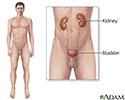Fractional excretion of sodium
FE sodium; FENa
Fractional excretion of sodium is the amount of salt (sodium) that leaves the body through urine compared to the amount filtered and reabsorbed by the kidney.
Fractional excretion of sodium (FENa) is not a test. Instead it is a calculation based on the concentrations of sodium and creatinine in the blood and urine. Urine and blood chemistry tests are needed to perform this calculation.
Urine
Urine chemistry is a group of one or more tests done to check the chemical content of a urine sample.

Blood chemistry
A comprehensive metabolic panel is a group of blood tests. They provide an overall picture of your body's chemical balance and metabolism. Metaboli...
How the Test is Performed
Blood and urine samples are collected at the same time and sent to a lab. There, they are examined for salt (sodium) and creatinine levels. Creatinine is a chemical waste product of creatine. Creatine is a chemical made by the body and is used to supply energy mainly to muscles.
Blood
Venipuncture is the collection of blood from a vein. It is most often done for laboratory testing.

Urine samples
A clean catch is a method of collecting a urine sample to be tested. The clean-catch urine method is used to prevent germs from the penis or vagina ...
How to Prepare for the Test
Eat your normal foods with a normal amount of salt, unless otherwise instructed by your health care provider.
If needed, you may be told to temporarily stop medicines that interfere with test results. For example, some diuretic medicines (water pills) can affect test results.
How the Test will Feel
When the needle is inserted to draw blood, some people feel moderate pain. Others feel only a prick or stinging. Afterward, there may be some throbbing or slight bruising. This soon goes away.
Why the Test is Performed
The test is usually done for people who are very ill with acute kidney disease . The test helps determine if the drop in urine production is due to reduced blood flow to the kidney or to kidney damage itself.
Acute kidney disease
Acute kidney failure is the rapid (less than 2 days) loss of your kidneys' ability to remove waste and help balance fluids and electrolytes in your b...

What Abnormal Results Mean
A meaningful interpretation of the test can be made only when your urine volume has dropped to less than 500 mL/day.
FENa of lower than 1% indicates decreased blood flow to the kidney. This can occur with kidney damage due to dehydration or heart failure .
Dehydration
Dehydration occurs when your body does not have as much water and fluids as it should. Dehydration can be mild, moderate, or severe, based on how muc...

Heart failure
Heart failure is a condition in which the heart is no longer able to pump oxygen-rich blood to the rest of the body efficiently. This causes symptom...

FENa higher than 1% suggests damage to the kidney itself.
Risks
Veins and arteries vary in size from one person to another and from one side of the body to the other. Obtaining a blood sample from some people may be more difficult than from others.
Other risks associated with having blood drawn are slight but may include:
- Excessive bleeding
- Fainting or feeling lightheaded
- Hematoma (blood accumulating under the skin)
- Infection (a slight risk any time the skin is broken)
- Multiple punctures to locate veins
There are no risks with the urine sample.
References
Parikh CR, Koyner JL. Biomarkers in acute and chronic kidney diseases. In: Skorecki K, Chertow GM, Marsden PA, Taal MW, Yu ASL, eds. Brenner and Rector's The Kidney . 10th ed. Philadelphia, PA: Elsevier; 2016:chap 30.
Polonsky TS, Bakris GL. Alterations in kidney function associated with heart failure. In: Mann DL, Felker GM, eds. Heart Failure: A Companion to Braunwald's Heart Disease . 3rd ed. Philadelphia, PA: Elsevier Saunders; 2016:chap 14.
Review Date: 10/13/2015
Reviewed By: Walead Latif DO, nephrologist, Medical Director of Fresenius Vascular Care, and Clinical Assistant Professor of Rutgers Medical School, Newark, NJ. Review provided by VeriMed Healthcare Network. Also reviewed by David Zieve, MD, MHA, Isla Ogilvie, PhD, and the A.D.A.M. Editorial team.

